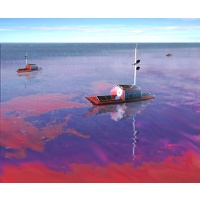Telesupervised Adaptive Ocean Sensor Fleet

This Project is no longer active.
Global ecosystems are changing as evidenced by increased frequency and severity of harmful algal blooms (HABs) in U.S. coastal environments and worldwide. Under certain conditions, fast-growing species of unicellular algae (a phytoplankton) rapidly form high-density blooms.
The harmful or toxic species can cause mass mortalities of marine organisms, disrupt ecosystem dynamics, and also cause a variety of human and animal illnesses. Other significant economic losses occur due to aquaculture business, fisheries, and tourism.
Scientific HAB studies have relied on collecting discrete water samples from hard-to-schedule, expensive research ships. Other studies use anchored or drifting sensor buoys which cannot be repositioned, do not enter coastal areas where HABs cause the greatest damage, and have limited operational lives. We are developing a HAB Investigation Telesupervised Adaptive Sensor System (HABITASS) to address these limitations.
The National Oceanographic and Atmospheric Administration (NOAA) is expanding an existing Ocean Atmosphere Sensor Integration System (OASIS) fleet that performs in-situ air and ocean surface observations. By extending the capabilities of OASIS to include a telesupervision software architecture, adaptive autonomous fleet control, and HAB-specific sensors, HABITASS will provide:
- Dynamic taskability and adaptation
- Greater insensitivity to weather than satellite systems
- Greater access to coastal waters than buoys
- Centralized analysis of collected data
- Real-time observation by remote oceanographers
Each platform is tasked from and communicates its data back to the Tele-Science Workstation.
By supporting oceanographers with multi-robot control software and automated science data analysis, this work will form a critical segment of the ocean portion of the Earth Science Sensor Web concept, supporting the prediction of outbreaks of HABs several days in advance of their occurrence, and providing more detailed information about the severity and the duration of any given outbreak.
This work is supported by a grant for Advanced Information Systems Technology from NASA’s Earth Science Technology Office.
current staff
past head
- John M Dolan
past staff
- Jeffrey J Baker
- Christopher R. Baker
- Alex Billing
- Imen Borgi
- Alberto Elfes
- Matthew Felser
- Jeff Hosler
- Kian Hsiang Low
- Tiffany Moisan
- John Moisan
- Gregg Podnar
- Ellie Lin Ratliff
- David Schlesinger
- Stephen B Stancliff
past contact
- Gregg Podnar

